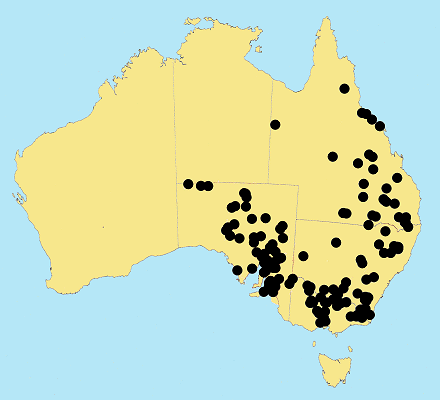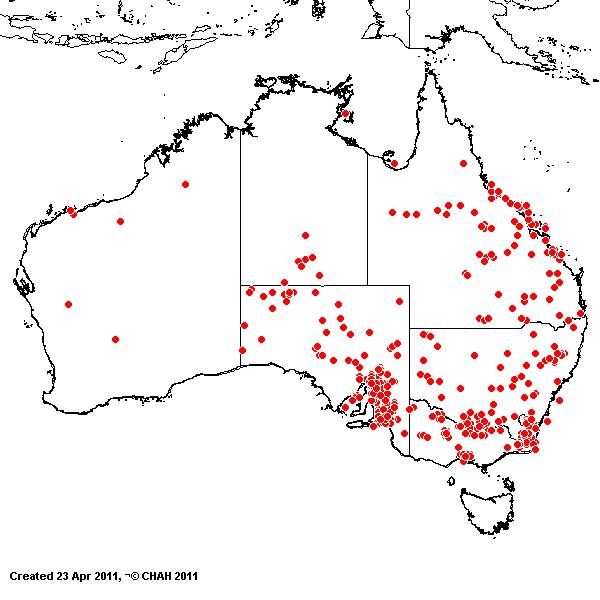Enneapogon nigricans (R.Br.) Beauv. Ess.
Agrost. 82, 161, 171 (1812).
Classification. (GPWG 2001) : Subfamily
Chloridoideae. Pappophoreae.
Basionym and/or
Replacement Name: Pappophorum
nigricans R. Br., Prodr. 185 (1812).
Type of Basionym or
Protologue Information: HT: R. Brown 6249 in part, Australia: New
South Wales: Prt Jackson (BM). LT designated (as type) by Burbidge, Proc.
Linn. Soc. London 153: 76–77 (1941).
Recent synonyms:
E. arenicola.
Key references (books
and floras): [1810]. R.Brown, Prodromus (185 as Pappophorum
nigricans), [1878] G.Bentham, Flora Australiensis 7 (600 as Pappophorum
nigricans), [1981] M.Lazarides in J.Jessop (ed)., Flora of Central
Australia (455), [2002] D.Sharp & B.K.Simon, AusGrass, Grasses of
Australia, [2006] J.Jessop, G.R.M.Dashorst, F.M.James, Grasses of South
Australia (334), [2008] S.W.L.Jacobs, R.D.B.Walley & D.J.B.Wheeler, Grasses
of New South Wales (241).
Illustrations:
[1984] N.T.Burbidge. rev. S.W.L.Jacobs, Australian Grasses (129), [2005] K.Mallet (ed.), Flora of
Australia 44B: Poaceae 3 (Fig. 30A-E), [2006] J.Jessop,
G.R.M.Dashorst, F.M.James, Grasses of South Australia (335, fig. 268), [2008] S.W.L.Jacobs,
R.D.B.Whalley & D.J.B.Wheeler, Grasses of New South Wales, 4th edn
(241).
Habit.
Perennial. Culms 5–55 cm tall. Mid-culm internodes pubescent. Lateral branches
simple or sparsely branched. Ligule a fringe of hairs. Leaf-blades flat or
involute, 1–5 mm wide. Leaf-blade surface indumented.
Inflorescence.
Inflorescence solid, a panicle. Panicle lanceolate or oblong or ovate, 0.8–9.5
cm long, 0.8–2.8 cm wide.
Spikelets.
Spikelets pedicelled. Fertile spikelets 1 or more flowered, with 1 fertile
floret, comprising 1 fertile floret(s), with diminished florets at the apex,
oblong, laterally compressed, 4–5 mm long.
Glumes.
Glumes similar, thinner than fertile lemma. Lower glume ovate, membranous,
without keels, 5–9 -nerved. Lower glume surface glabrous or indumented. Upper
glume ovate, 3.5–8 mm long, membranous, without keels, 5–9 -nerved. Upper glume
surface smooth or asperulous, glabrous or indumented.
Florets.
Fertile lemma 2–3.6 mm long, without keel, 9–11 -nerved. Lemma surface
indumented. Lemma apex dentate or lobed, awned, 9 -awned. Median (principal)
awn 3–7.8 mm long overall. Lateral lemma awns present. Palea apex with
excurrent keel nerves or awned. Lodicules present. Anthers 3. Grain 1.2–2.2 mm
long.
Continental
Distribution: Australasia.
Australian
Distribution: South Australia, Queensland, New South Wales, Victoria.
South Australia:
North-western, Lake Eyre, Gairdner-Torrens Basin, Flinders Ranges, Eastern,
Eyre Peninsula, Northern Lofty, Murray, Yorke Peninsula, Southern Lofty,
South-eastern. Queensland: Burke, Darling Downs, Leichhardt, Maranoa,
Port Curtis, Cook, North Kennedy, South Kennedy. New South Wales: North
Coast, South Coast, Central Tablelands, Southern Tablelands, North-Western
Slopes, Central-Western Slopes, South-Western Slopes, North-Western Plains,
South-Western Plains, North Far Western Plains, South Far Western Plains. Victoria:
East Gippsland, Gippsland Plain, Midlands, Murray Mallee, Riverina, Volcanic
Plain, Wimmera.
Notes.
A widespread species, variable especially in panicle shape and lemma nervation,
which has been misidentified with E. truncatus and E. gracilis.
Identification depends on a combination of many characters, rather than on any
one diagnostic feature. E. arenicolus, originally a segregate, lacks any
discontinuous characters and falls within the range of variation found in E.
nigricans.

Distributed
in Qld, N.S.W., Vic. and S.A.


